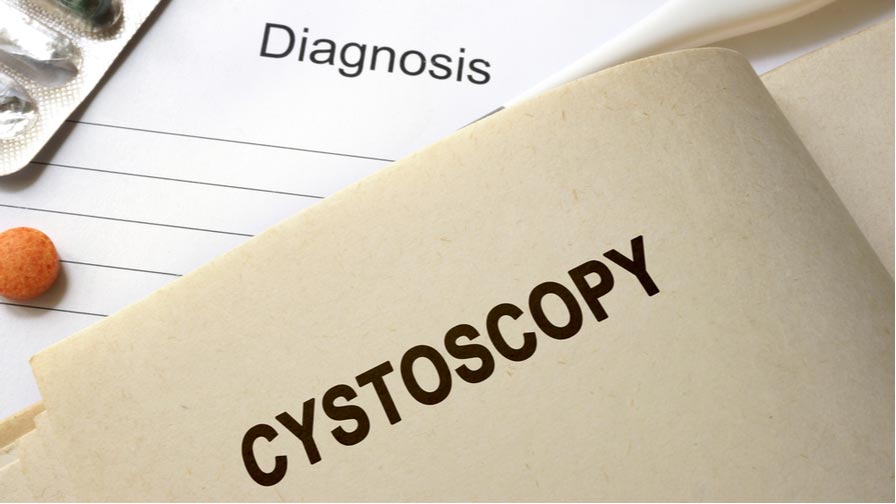Cystoscopy: Purpose, Procedure, Risks and Recovery
Schedule Your
Appointment
Cystoscopy: Overview
Cystoscopy is the medical procedure that allows the doctor to examine the inner lining of the urinary bladder and urethra, the tube that carries urine out of the body. During the procedure, a hollow tube known as a cystoscope, equipped with a lens on its top is inserted into the urethra and then slowly advanced into the bladder.
The type of cystoscopy that a patient needs depends on the reason for which he or she is undergoing the procedure.

Why is Cystoscopy Done?
Cystoscopy is done to diagnose, monitor, or treat the conditions affecting the urinary bladder and the urethra. The doctor may recommend cystoscopy for the following reasons:
- To investigate causes of signs and symptoms including blood in urine, urinary incontinence, pelvic pain, overactive bladder and dysuria (painful urination). Cystoscopy can also help to determine the causes of frequent UTIs. Cystoscopy is not generally done while the patient has an active UTI.
- To diagnose diseases and conditions in the bladder like bladder cancer, bladder stones and cystitis bladder inflammation.
- To treat diseases and conditions of the bladder. For this, special tools can be passed through the cystoscope, during the process of cystoscopy.
- Cystoscopy is carried out to diagnose enlarged prostate. The procedure can show narrowing of the urethra where it passes through the prostate gland, showing an enlarged prostate, also known as benign prostatic hyperplasia.
The doctor may also conduct a second procedure called ureteroscopy along with cystoscopy. During a ureteroscopy, a small scope is used to examine the tubes carry urine from the kidneys to the bladder or ureters. A cystoscopy can also reveal conditions such as tumors or stones in the bladder, or bladder cancer. The doctor can also use a cystoscopy procedure to diagnose the following:
- Blockages
- Enlarged prostate gland
- Non-cancerous tumors or growth
- Problems with the ureters
Preparing for a Cystoscopy
Cystoscopy Procedure
Right before the cystoscopy, the patient is asked to go to the bathroom to pee and empty the bladder. Then, the patient has to change into a surgical gown and lie down on his back for the procedure, with his feet positioned in stirrups. The patient may be given antibiotics to help prevent any bladder infections.The patient is then given a local or general anesthesia. The doctor will numb the bladder with an anesthetic spray or gel. The patient may still feel some sensations, but the procedure is not painful. Before inserting the cystoscope into the urethra, the doctor will lubricate the cystoscope with gel. This may give a slight burning sensation. For diagnostic cystoscopy, the doctor will use a flexible scope. For biopsies or surgical procedures, a slightly thicker and rigid cystoscope is used. A bigger cystoscope easily allows the surgical instruments to pass.As the cystoscope enters the bladder, the doctor will look through the lens present on the top of the scope. A sterile solution which flows through and floods the bladder is passed through the cystoscope. This is done to clear out the bladder for a clearer vision. As the sterile solution fills up the bladder, the patient may have a feeling a need to urinate.If local anesthesia is used, the cystoscopy takes about 5 to 10 minutes. If the patient is given general anesthesia or is sedated, the procedure may take about 15 to 30 minutes.Potential Risks associated with Cystoscopy
Urethritis (swollen urethra)
This is the most common complication which makes urination difficult. In case you cannot urinate for more than 8 hours after the procedure, get in touch with your doctor immediately.
Infection
In rare cases, during cystoscopy, germs may enter the urinary tract and cause infections. Symptoms of such infection include high fever, strange and smelly urine, nausea, and lower back pain. The doctor might prescribe antibiotics to the patient to treat the infection.Bleeding
In rare cases, patients suffer from serious bleeding after the procedure. Contact your doctor if this happens to you.In case the patient had a biopsy during the procedure, the patient may have a little blood in the urine. Doctors suggest drinking a lot of water which can help ease the burning sensation and bleeding.
The patient is advised to keep an eye on the symptoms and call the doctor in case the following symptoms are observed:
Bright red colored blood or blood clots in urine
Pinkish colored urine for more than 3 days
Burning sensation while urinating for more than 3 days
Constant or severe pain which is not relieved even after taking pain medication
Fever and chills
Lower back pain
Inability to pass urine
What Happens after a Cystoscopy?
After a cystoscopy, the patient may be advised to stay in the hospital for observation in case sedation or general anesthesia is used. Once the patient’s heart rate and pulse,blood pressure and breathing is stable, he can go home. Cystoscopy is mostly done as an outpatient procedure.
The patient can go back to resume his regular diet and activities after the procedure. The patient is encouraged to drink a lot of fluids as it will dilute the urine and reduce urinary discomforts like burning sensation while passing urine. A sitz bath or warm tub bath is helpful in easing the symptoms of urinary discomfort.
The patient may also notice blood in urine after cystoscopy. This is normal and usually clears up in a day or two. Pain reliever can help ease soreness or discomfort. Medications such as aspirin can increase the risk of bleeding. So, apart from the ones prescribed by the doctor, do not take any medication without consulting. Patients are generally given antibiotics after the procedure to help prevent infection.
Recovering after a Cystoscopy
Our Clinical Footprint

30000+
Happy Patients
10000+
Surgeries
100+
Doctors
70+
Clinics
20+
Cities
200+
Hospitals
Our Clinical Footprint

30000+
Happy Patients
10000+
Surgeries
100+
Doctors
70+
Clinics
20+
Cities
200+
Hospitals